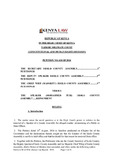Musa germplasm diversity status across a wide range of agro-ecological zones in Rwanda

View/
Date
2014-01Author
Ocimati, W
Blomme, G
Rutikanga, A
Karamura, D
Ragama, P
Gaidashova, S
Nsabimana, A
Murekezi, C
Metadata
Show full item recordAbstract
Objectives: This study assessed the on-farm Musa germplasm diversity across different agro-ecologies of
Rwanda and the socio-economic utilization options and selection practices that create/maintain this
diversity on-farm.
Methodology and results: A Musa germplasm diagnostic survey was carried out in 2007 in five Rwandan
districts on a transect from Lake Kivu (West) to Kirehe district (East) bordering Tanzania. Across all sites,
118 farms, each having at least 50 mats were sampled for determining Musa diversity. Forty three Musa
cultivars were recorded across the five districts. Higher diversity was observed in the east declining
westwards to the Lake Kivu region as reflected by the number of cultivars and their relative abundance.
Nearly half of the recorded cultivars had a low diversity index (Gini-Simpson 1-D < 0.2) and therefore prone
to genetic erosion. Cooking cultivars only dominate in the district of Kirehe, while beer cultivars dominate
the banana production landscape in the other districts. Taste/flavor, bunch size and market demand were
the most important criteria for banana cultivar selection and thus greatly influenced cultivar conservation
and distribution on-farm. Diseases such as Fusarium wilt and Xanthomonas wilt greatly contributed to
genetic erosion.
Conclusion and application of results: Musa cultivar diversity in Rwanda is under threat. Ex-situ
conservation of the menaced cultivars is of crucial importance. Beer cultivars dominated the landscape.
Cultivar diversity on-farm was influenced by the prevailing altitude; taste/flavor, bunch size, and market
demand of the cultivars; and their susceptibility to diseases especially Fusarium and Xanthomonas wilt.
Banana breeding or adaptation strategies therefore should take into account the farmer preferred traits. In
addition, strategies for managing these diseases are critical for preventing the genetic erosion of the
affected cultivars.
Collections
- Publications 2019 [91]
